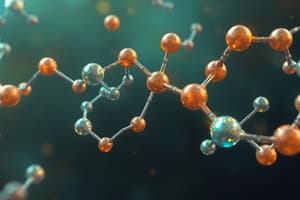Podcast
Questions and Answers
Which of the following is NOT a known transporter involved in regulating glycine levels at the synapse?
Which of the following is NOT a known transporter involved in regulating glycine levels at the synapse?
- SMHT (correct)
- VIAAT
- GLYT1
- GLYT2
Where is GLYT2 primarily expressed?
Where is GLYT2 primarily expressed?
- Postsynaptic terminals
- Axons and presynaptic terminals (correct)
- Presynaptic terminals
- Astrocytes
Which of the following is NOT true about the degradation of glycine?
Which of the following is NOT true about the degradation of glycine?
- Glycine degradation is initiated by the SMHT enzyme. (correct)
- Glycine degradation occurs in mitochondria.
- Glycine degradation is a crucial step in the removal of glycine from the synaptic cleft.
- Glycine degradation uses the glycine cleavage system (GCS).
What is the function of GLYT1 in the forebrain?
What is the function of GLYT1 in the forebrain?
Which of the following is TRUE about the expression of GLYT1?
Which of the following is TRUE about the expression of GLYT1?
What is the primary function of GLYT1 and GLYT2?
What is the primary function of GLYT1 and GLYT2?
Which of the following statements ACCURATELY describes the relationship between glycine and the NMDA receptor?
Which of the following statements ACCURATELY describes the relationship between glycine and the NMDA receptor?
Which of the following is TRUE regarding the synthesis of glycine?
Which of the following is TRUE regarding the synthesis of glycine?
Why does GLYT1 exist in different isoforms?
Why does GLYT1 exist in different isoforms?
Which of the following statements is TRUE regarding the symptoms of hereditary hyperekplexia in older individuals?
Which of the following statements is TRUE regarding the symptoms of hereditary hyperekplexia in older individuals?
Based on the provided text, what is the most likely cause of the transient breathing difficulties experienced by infants with hereditary hyperekplexia?
Based on the provided text, what is the most likely cause of the transient breathing difficulties experienced by infants with hereditary hyperekplexia?
Which of the following is a TRUE statement about the progression of hereditary hyperekplexia?
Which of the following is a TRUE statement about the progression of hereditary hyperekplexia?
Based on the text, the statement that hereditary hyperekplexia is characterized by hypertonia 'except when they are sleeping' implies that:
Based on the text, the statement that hereditary hyperekplexia is characterized by hypertonia 'except when they are sleeping' implies that:
Given the symptoms and progression of hereditary hyperekplexia, which of the following statements is the LEAST likely explanation for the observed fading of symptoms by age 1?
Given the symptoms and progression of hereditary hyperekplexia, which of the following statements is the LEAST likely explanation for the observed fading of symptoms by age 1?
Which substance is identified as the main inhibitory neurotransmitter in the adult nervous system?
Which substance is identified as the main inhibitory neurotransmitter in the adult nervous system?
What is synthesized by the enzyme glutamic acid decarboxylase?
What is synthesized by the enzyme glutamic acid decarboxylase?
Which of the following substances is mentioned as being seized at breweries in London?
Which of the following substances is mentioned as being seized at breweries in London?
What is a primary conclusion of William Black regarding the brewing of porter?
What is a primary conclusion of William Black regarding the brewing of porter?
According to William Black, what contributes to the intoxicating qualities of porter?
According to William Black, what contributes to the intoxicating qualities of porter?
Which of the following drugs is specifically mentioned as having been used in brewing?
Which of the following drugs is specifically mentioned as having been used in brewing?
What effect does the quantity of stupefying ingredients have on porter according to historical claims?
What effect does the quantity of stupefying ingredients have on porter according to historical claims?
What characterizes GABAC receptors in terms of agonist activation?
What characterizes GABAC receptors in terms of agonist activation?
Which statement is true regarding the composition of GABAA receptors?
Which statement is true regarding the composition of GABAA receptors?
Which GABAA receptor subtype exhibits the most prevalence in the brain?
Which GABAA receptor subtype exhibits the most prevalence in the brain?
In which brain regions are GABAA receptors containing the α2 subunit most abundant?
In which brain regions are GABAA receptors containing the α2 subunit most abundant?
What is the primary basis for differentiating GABAA and GABAC receptors?
What is the primary basis for differentiating GABAA and GABAC receptors?
What is the stoichiometry of the major GABAA receptor subtype found in the brain?
What is the stoichiometry of the major GABAA receptor subtype found in the brain?
What type of receptor is GABAA categorized as?
What type of receptor is GABAA categorized as?
Which of the following statements about GABAC receptors is correct?
Which of the following statements about GABAC receptors is correct?
What can be concluded about the relationship between GABAC receptors and GABAA receptors?
What can be concluded about the relationship between GABAC receptors and GABAA receptors?
Which of the following statements regarding glycine receptors is TRUE?
Which of the following statements regarding glycine receptors is TRUE?
Why can glycine act as an excitatory neurotransmitter in the embryonic nervous system?
Why can glycine act as an excitatory neurotransmitter in the embryonic nervous system?
What is the primary mechanism by which alcohols modulate glycine receptors?
What is the primary mechanism by which alcohols modulate glycine receptors?
Based on the provided information, which of the following neurotransmitters can be considered both excitatory and inhibitory depending on the developmental stage?
Based on the provided information, which of the following neurotransmitters can be considered both excitatory and inhibitory depending on the developmental stage?
In the context of embryonic nervous system development, what likely happens to the Cl- reversal potential as the nervous system matures?
In the context of embryonic nervous system development, what likely happens to the Cl- reversal potential as the nervous system matures?
Which of these factors contributes to the transition of glycine from an excitatory neurotransmitter to an inhibitory one during development?
Which of these factors contributes to the transition of glycine from an excitatory neurotransmitter to an inhibitory one during development?
Based on the provided information, what is the MOST likely reason that β-mRNA is abundant in the CNS but does not alone create glycine receptors?
Based on the provided information, what is the MOST likely reason that β-mRNA is abundant in the CNS but does not alone create glycine receptors?
Select the option that is TRUE about the relationship between glycine receptors and inherited hyperekplexia.
Select the option that is TRUE about the relationship between glycine receptors and inherited hyperekplexia.
Which of the following drugs, based on the information given, is LIKELY to have an effect on glycine receptors?
Which of the following drugs, based on the information given, is LIKELY to have an effect on glycine receptors?
Which of the following is a REASONABLE inference regarding the role of KCC2 transporter in the development of the nervous system?
Which of the following is a REASONABLE inference regarding the role of KCC2 transporter in the development of the nervous system?
Flashcards
GABA (Gamma-Aminobutyric Acid)
GABA (Gamma-Aminobutyric Acid)
A chemical compound that is the main inhibitory neurotransmitter in the adult nervous system.
Glutamic Acid Decarboxylase (GAD)
Glutamic Acid Decarboxylase (GAD)
An enzyme that is responsible for the synthesis of GABA from glutamic acid.
Glutamic Acid
Glutamic Acid
A chemical compound that is the precursor to GABA.
Synthesis (in Neuropharmacology)
Synthesis (in Neuropharmacology)
Signup and view all the flashcards
Excitatory Neurotransmitter
Excitatory Neurotransmitter
Signup and view all the flashcards
Inhibitory Neurotransmitter
Inhibitory Neurotransmitter
Signup and view all the flashcards
Glutamate
Glutamate
Signup and view all the flashcards
What are GABAA receptors?
What are GABAA receptors?
Signup and view all the flashcards
What are GABAC receptors?
What are GABAC receptors?
Signup and view all the flashcards
What are Ionotropic receptors?
What are Ionotropic receptors?
Signup and view all the flashcards
What are Metabotropic receptors?
What are Metabotropic receptors?
Signup and view all the flashcards
What are GABA receptors?
What are GABA receptors?
Signup and view all the flashcards
What are Heteromeric ionotropic receptors?
What are Heteromeric ionotropic receptors?
Signup and view all the flashcards
What are Homomeric ionotropic receptors?
What are Homomeric ionotropic receptors?
Signup and view all the flashcards
What are Heteromeric metabotropic receptors?
What are Heteromeric metabotropic receptors?
Signup and view all the flashcards
What is the major GABAA receptor subtype in the brain?
What is the major GABAA receptor subtype in the brain?
Signup and view all the flashcards
Hereditary Hyperekplexia
Hereditary Hyperekplexia
Signup and view all the flashcards
Startle Response
Startle Response
Signup and view all the flashcards
Hypertonia
Hypertonia
Signup and view all the flashcards
Hypnagogic Myoclonus
Hypnagogic Myoclonus
Signup and view all the flashcards
Rigidity
Rigidity
Signup and view all the flashcards
Vesicular Glycine Transporter
Vesicular Glycine Transporter
Signup and view all the flashcards
VIAAT (Vesicular Inhibitory Amino Acid Transporter)
VIAAT (Vesicular Inhibitory Amino Acid Transporter)
Signup and view all the flashcards
Serine Hydroxymethyltransferase (SMHT)
Serine Hydroxymethyltransferase (SMHT)
Signup and view all the flashcards
GLYT1
GLYT1
Signup and view all the flashcards
GLYT2
GLYT2
Signup and view all the flashcards
Glycine Cleavage System (GCS)
Glycine Cleavage System (GCS)
Signup and view all the flashcards
Glycinergic Synaptic Transmission
Glycinergic Synaptic Transmission
Signup and view all the flashcards
Synaptic Cleft
Synaptic Cleft
Signup and view all the flashcards
Glycine Receptor
Glycine Receptor
Signup and view all the flashcards
Glycine Removal
Glycine Removal
Signup and view all the flashcards
Glycine in the Embryonic Nervous System
Glycine in the Embryonic Nervous System
Signup and view all the flashcards
Glycinergic Synapse
Glycinergic Synapse
Signup and view all the flashcards
K+/Cl- Co-transporter KCC2
K+/Cl- Co-transporter KCC2
Signup and view all the flashcards
Depolarization
Depolarization
Signup and view all the flashcards
Reversal Potential
Reversal Potential
Signup and view all the flashcards
Modulation of Glycine Receptors
Modulation of Glycine Receptors
Signup and view all the flashcards
Allosteric Modulation
Allosteric Modulation
Signup and view all the flashcards
Allosteric Binding
Allosteric Binding
Signup and view all the flashcards
Study Notes
GABA & Glycine
- GABA and glycine are neurotransmitters, crucial for inhibitory functions in the adult nervous system.
- Ironically, the precursor to GABA is glutamate, a major excitatory neurotransmitter.
- GABA is synthesized via the enzyme glutamic acid decarboxylase (GAD).
- GAD (65 and/or 67) is localized specifically on GABAergic neurons.
- GABA is present throughout the brain in diverse inhibitory interneurons (e.g., basket, stellate) and projection neurons (e.g., Purkinje).
- GABA is transported back into GABAergic terminals via dedicated GABA transporters.
- GABA is also buffered by astrocytes where it is degraded by GABA transaminase (GABA-T).
- This process results in a net flow of GABA from neuronal to astrocytic compartments.
- Compensatory flow of a GABA precursor is needed to maintain this balance.
- GABA-related proteins like GAD, GABA-T, and GATs have specific locations and functions.
- GABA receptors (GABAA, GABAB, GABAC) have diverse roles and are modulated by various substances (e.g., alcohol, anaesthetics, benzodiazepines, etc).
Receptor Nomenclature
- GABA receptors form complexes with different subunits (homomeric and heteromeric), and their respective types.
- GABAA, GABAB, and GABAC receptors have differing properties including the types of ions involved, their locations, and their roles in the nervous system.
- The Greek letters denote subunit families, each with significant homology in amino acid sequence (specifically about 70%).
- The related homology between families is around 30-40%.
- GABAA receptors are chloride channels, while GABAB is a G protein-coupled receptor.
- GABAC receptors are homomeric, containing only rho subunits.
Drugs Affecting GABAergic Transmission
- Drugs can modulate GABAergic transmission through various mechanisms.
- Agonists often enhance GABAergic activity, and antagonists reduce it.
- Different drugs target different GABA receptors.
- Examples of drugs impacting relevant receptors include benzodiazepines, barbiturates, and some anaesthetics.
Case Study - Adulteration
- The case study involving the adulteration of beer exemplifies the use of various substances to alter flavour and perceived strength, including toxins and other harmful compounds.
- Brewers used different products, such as cocculus indicus in an attempt to enhance flavour and masking of poor products.
- Authorities took measures to control these adulteration practices.
Case Study - Performance Enhancement
- Historically, substances like strychnine were used as performance enhancers.
- Strychnine is a potent convulsant, and its use in sports competitions was a significant concern.
- Athletic performance enhancers have ethical and legal implications.
- Contemporary athletic guidelines address the use of performance-enhancing substances.
Glycine in Synaptic Transmission
- Glycine is a major neurotransmitter in the nervous system, and it has similar characteristics to GABA.
- Glycine is synthesized from serine by serine hydroxymethyltransferase (SMHT).
- Glycine is packaged into vesicles, transported in the synaptic cleft by uptake transporters on astrocytes and presynaptic terminals (GLYT1 and GLYT2).
- GLYT1 and GLYT2 are expressed throughout the brain, performing a crucial role.
- Degradation occurs through the glycine cleavage system in mitochondria. Glycine receptors are impacted by various drugs.
Glycine Receptors
- Glycine receptors are a class of ionotropic receptors, with specific subunit compositions and functions.
- Glycine receptors are related to nicotinic cholinergic and 5-HT3 receptors, possessing a pentameric structure.
- Glycine receptors are activated by glycine and are inhibited by strychnine.
- Glycine receptors have specific regional and developmental regulation, notably with the alpha subunits determining location, influencing the physiological roles of glycine.
Ethanol and GABA/Glycine Receptors
- Ethanol enhances GABAA receptor-mediated synaptic inhibition.
- Ethanol affects GABAA receptor function and consequently increases efficacy of glycine.
- Blocking GABAB receptors enhances effect of ethanol.
- Ethanol may impact other neurotransmitter systems like glutamate in different ways.
GABA and Disease
- GABAergic neurotransmission plays a role in various neuropsychiatric disorders, including epilepsy, Huntington's disease, tardive dyskinesia, alcoholism and sleep disorders.
- In some conditions, imbalances in GABA neurotransmission can affect neuronal activity, contributing to disease processes.
GABAergic System Deficiency
- GABA transaminase (GABA-T) deficiency, a genetic disorder, leads to recurrent seizures, uncontrolled movements and other complications in infants.
- Symptoms are present early in infancy.
- These patients have difficulty thriving and developing.
Embryonic Nervous System and GABA/Glycine
- GABA and glycine can cause depolarization in the embryonic nervous system, which contrasts to their inhibitory role in the adult nervous system.
- In early stages of development, GABA can affect neuron activity in an excitatory way.
- This early excitatory role is essential for CNS development.
Receptor Modulation
- Glycine receptors are allosterically modulated.
- Alcohol impacts glycine receptors and GABA receptors in different ways.
Additional Notes (from various pages)
- Strychnine: a substance historically used as a performance enhancer, now forbidden in sports competition due to its convulsive properties.
- Several case studies provide historical examples of substances used or abused in the past in an attempted performance enhancement which often highlighted ethical considerations.
- Learning Outcomes: Specific outcomes mentioned include discussing various transmitters, their actions, and agonists/antagonists, along with examining associated diseases and case studies.
- There's a specific concern with learning outcomes tied to performance enhancement.
- The pharmacology of GABA and glycine is crucial for understanding diverse neurological and psychiatric conditions.
Studying That Suits You
Use AI to generate personalized quizzes and flashcards to suit your learning preferences.




